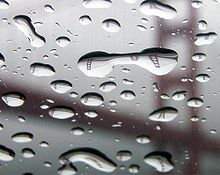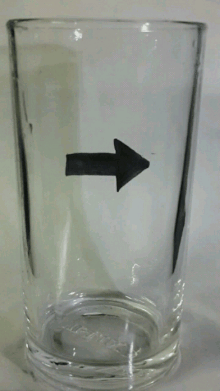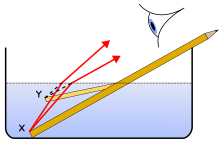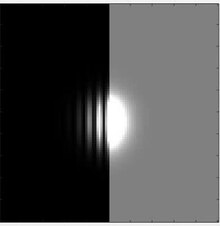Light on air–plexi surface in this experiment undergoes refraction (lower ray) and reflection (upper ray).
Refraction in a glass of water. The image is flipped.
An image of the Golden Gate Bridge is refracted and bent by many differing three-dimensional drops of water.
This is how light refracts through different materials.
An
object (in this case a pencil) part immersed in water looks bent due to
refraction: the light waves from X change direction and so seem to
originate at Y. (More accurately, for any angle of view, Y should be
vertically above X, and the pencil should appear shorter, not longer as
shown.)
Refraction of a spoon
The phenomenon is explained by the conservation of energy and the conservation of momentum. Owing to the change of medium, the phase velocity of the wave is changed but its frequency remains constant. This is most commonly observed when a wave passes from one medium to another at any angle other than 0° from the normal. Refraction of light is the most commonly observed phenomenon, but any type of wave can refract when it interacts with a medium, for example when sound waves pass from one medium into another or when water waves move into water of a different depth. Refraction follows Snell's law, which states that, for a given pair of media and a wave with a single frequency, the ratio of the sines of the angle of incidence θ1 and angle of refraction θ2 is equivalent to the ratio of phase velocities (v1 / v2) in the two media, or equivalently, to relative indices of refraction (n2 / n1) of the two media. Epsilon(
 ) and mu(
) and mu( ) represent the dielectric constant and the magnetic moment of the different media:
) represent the dielectric constant and the magnetic moment of the different media:
Explanation
Refraction of light at the interface between two media of different refractive indices, with n2 > n1. Since the phase velocity is lower in the second medium (v2 < v1), the angle of refraction θ2 is less than the angle of incidence θ1; that is, the ray in the higher-index medium is closer to the normal.
In optics, refraction is a phenomenon that often occurs when waves travel from a medium with a given refractive index to a medium with another at an oblique angle. At the boundary between the media, the wave's phase velocity is altered, usually causing a change in direction. Its wavelength increases or decreases, but its frequency remains constant. For example, a light ray will refract as it enters and leaves glass, as there is a change in refractive index. A ray traveling along the normal (perpendicular to the boundary) will suffer change in speed, but not direction. Refraction still occurs in this case (by Snell's Law as angle of incidence will be 0°). Understanding of this concept led to the invention of lenses and the refracting telescope.
Refraction can be seen when looking into a bowl of water. Air has a refractive index of about 1.0003, and water has a refractive index of about 1.3333. If a person looks at a straight object, such as a pencil or straw, which is placed at a slant, partially in the water, the object appears to bend at the water's surface. This is due to the bending of light rays as they move from the water to the air. Once the rays reach the eye, the eye traces them back as straight lines (lines of sight). The lines of sight (shown as dashed lines) intersect at a higher position than where the actual rays originated. This causes the pencil to appear higher and the water to appear shallower than it really is. The depth that the water appears to be when viewed from above is known as the apparent depth. This is an important consideration for spearfishing from the surface because it will make the target fish appear to be in a different place, and the fisher must aim lower to catch the fish. Conversely, an object above the water has a higher apparent height when viewed from below the water. The opposite correction must be made by an archer fish. For small angles of incidence (measured from the normal, when sin θ is approximately the same as tan θ), the ratio of apparent to real depth is the ratio of the refractive indexes of air to that of water. But, as the angle of incidence approaches 90o, the apparent depth approaches zero, albeit reflection increases, which limits observation at high angles of incidence. Conversely, the apparent height approaches infinity as the angle of incidence (from below) increases, but even earlier, as the angle of total internal reflection is approached, albeit the image also fades from view as this limit is approached.
Diagram of refraction of water waves
The diagram on the right shows an example of refraction in water waves. Ripples travel from the left and pass over a shallower region inclined at an angle to the wavefront. The waves travel slower in the more shallow water, so the wavelength decreases and the wave bends at the boundary. The dotted line represents the normal to the boundary. The dashed line represents the original direction of the waves. This phenomenon explains why waves on a shoreline tend to strike the shore close to a perpendicular angle. As the waves travel from deep water into shallower water near the shore, they are refracted from their original direction of travel to an angle more normal to the shoreline. Refraction is also responsible for rainbows and for the splitting of white light into a rainbow-spectrum as it passes through a glass prism. Glass has a higher refractive index than air. When a beam of white light passes from air into a material having an index of refraction that varies with frequency, a phenomenon known as dispersion occurs, in which different coloured components of the white light are refracted at different angles, i.e., they bend by different amounts at the interface, so that they become separated. The different colors correspond to different frequencies.
While refraction allows for phenomena such as rainbows, it may also produce peculiar optical phenomena, such as mirages and Fata Morgana. These are caused by the change of the refractive index of air with temperature.
The refractive index of materials can also be nonlinear, as occurs with the Kerr effect when high intensity light leads to a refractive index proportional to the intensity of the incident light.
Recently, some metamaterials have been created that have a negative refractive index. With metamaterials, we can also obtain total refraction phenomena when the wave impedances of the two media are matched. There is then no reflected wave.
Also, since refraction can make objects appear closer than they are, it is responsible for allowing water to magnify objects. First, as light is entering a drop of water, it slows down. If the water's surface is not flat, then the light will be bent into a new path. This round shape will bend the light outwards and as it spreads out, the image you see gets larger.
Refraction of light at the interface between two media.
2D
simulation: refraction of a quantum particle.The black half of the
background is zero potential, the gray half is a higher potential. White
blur represents the probability distribution of finding a particle in a
given place if measured.
An analogy that is often put forward to explain the refraction of light is as follows: "Imagine a marching band as it marches at an oblique angle from a pavement (a fast medium) into mud (a slower medium). The marchers on the side that runs into the mud first will slow down first. This causes the whole band to pivot slightly toward the normal (make a smaller angle from the normal)."
Why refraction occurs when light travels from a medium with a given refractive index to a medium with another, can be explained by the path integral formulation of quantum mechanics (the complete method was developed in 1948 by Richard Feynman). Feynman humorously explained it himself in the recording "QED: Fits of Reflection and Transmission - Quantum Behaviour - Richard Feynman (The Sir Douglas Robb Lectures, University of Auckland, 1979)".
The effects of refraction between materials can be minimised through index matching, the close matching of their respective indices of refraction.











